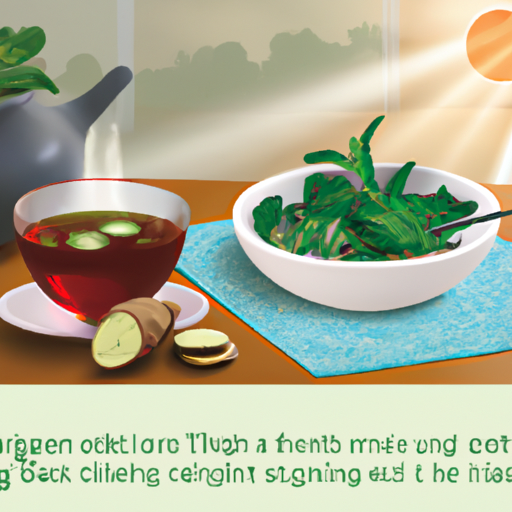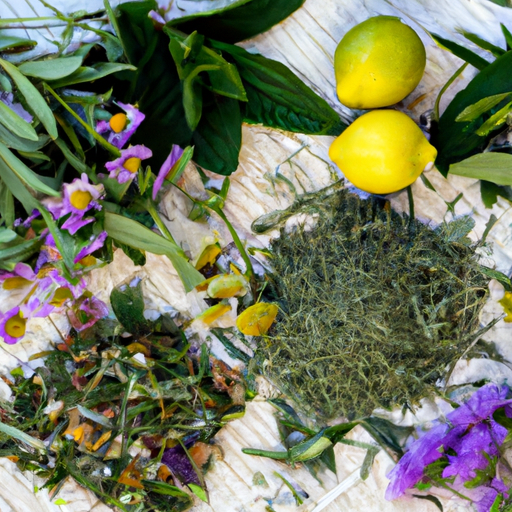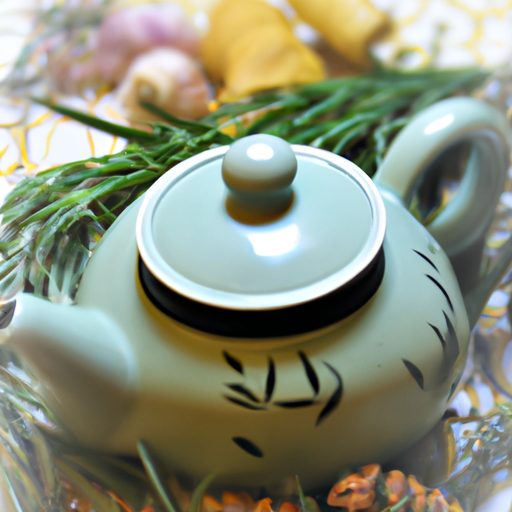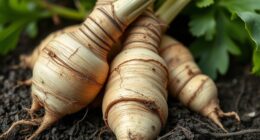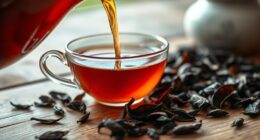Did you know that more than 40% of adults in the United States face weight problems? If you are among them, know that you are not alone. It can be difficult to find the right strategies to aid in weight loss, but one solution that is both natural and effective is herbal tea.
Herbal teas have been used for centuries for their various health benefits, including weight loss support. In this article, I will explore the best herbal teas that can help you shed those extra pounds and achieve your weight loss goals.
Green tea, known for its high antioxidant content, has been widely studied for its potential to boost metabolism and burn fat. Oolong tea, a traditional Chinese tea, has also shown promising results in weight loss studies. Peppermint tea can help suppress appetite and aid digestion, while ginger tea can increase calorie burning and reduce cravings. Rooibos tea is not only caffeine-free, but it also contains compounds that can help regulate blood sugar levels, promoting weight loss. Dandelion tea acts as a natural diuretic, helping to eliminate excess water weight. Lastly, hibiscus tea has been shown to inhibit the production of new fat cells.
By incorporating these herbal teas into your weight loss journey, you can enjoy a delicious and natural way to support your goals. Let’s dive into the world of herbal teas and discover the best options for you.
Key Takeaways
- Green tea is a powerful herbal tea that supports weight loss due to its high antioxidants, metabolism-boosting properties, fat-burning effects, and ability to regulate hunger and cravings.
- Oolong tea is another beneficial herbal tea that aids in weight loss by boosting metabolism, reducing fat absorption, and curbing cravings.
- Peppermint tea helps with weight loss by suppressing appetite, increasing energy levels, reducing food cravings, and soothing digestive issues.
- Ginger tea promotes weight loss through increased calorie burning, fat oxidation, digestion support, reduced joint pain and inflammation, metabolism stimulation, appetite suppression, and reduced cravings.
Green Tea
You’ll find that green tea is the best herbal option for aiding in weight loss. When it comes to shedding those extra pounds, green tea has been widely studied and proven to have numerous benefits. So, does green tea really work? The answer is yes!
Green tea contains catechins, which are powerful antioxidants that can help boost metabolism and increase fat oxidation. These compounds also have the potential to reduce appetite and inhibit the absorption of fat. Additionally, green tea can provide a slight increase in energy expenditure, leading to greater calorie burning throughout the day. Research has shown that regularly consuming green tea can lead to modest weight loss and a decrease in body fat.
It’s important to note that green tea should not be seen as a miracle weight loss solution, but rather as a helpful tool in conjunction with a balanced diet and regular exercise. With all these benefits, it’s clear why green tea is a popular choice for those aiming to lose weight.
Now, let’s move on to the next section about oolong tea.
Oolong Tea
Indulge in the invigorating effects of Oolong tea to trim down and transform your physique! Oolong tea, known for its weight loss benefits, is a type of traditional Chinese tea that combines the qualities of green and black tea. Here are three reasons why Oolong tea is an excellent choice for supporting weight loss:
-
Boosts metabolism: Oolong tea contains polyphenols, which help increase metabolism and fat oxidation. This means that your body can burn more calories even when you’re at rest.
-
Reduces fat absorption: Studies have shown that Oolong tea can inhibit the enzymes responsible for fat absorption. By drinking Oolong tea regularly, you can reduce the amount of dietary fat that your body absorbs.
-
Curbs cravings: Oolong tea has been found to regulate blood sugar levels, which can help control cravings for sugary and high-calorie foods. By drinking Oolong tea instead of reaching for unhealthy snacks, you can better manage your calorie intake.
When brewing Oolong tea, it’s essential to use water that’s around 195-205°F (90-96°C) and steep the leaves for 3-5 minutes. This will ensure that you extract the maximum amount of beneficial compounds from the tea leaves.
Transitioning into the next section, let’s explore the weight loss benefits of peppermint tea.
Peppermint Tea
Peppermint tea is a fantastic herbal option for those looking to support their weight loss journey. It’s been shown to suppress appetite and reduce food cravings, making it easier to stick to a healthy eating plan.
Additionally, peppermint tea can soothe digestive issues and bloating, promoting a comfortable and efficient digestive system.
Lastly, this refreshing tea can help increase energy levels and focus, giving you the boost you need to stay active and motivated throughout the day.
Suppresses Appetite and Reduces Food Cravings
One fantastic choice for those looking to suppress their appetite and reduce food cravings is green tea, renowned for its weight loss benefits. Green tea has been shown to have positive effects on the nervous system, helping to regulate hunger and control cravings. It contains compounds like caffeine and catechins that can stimulate the release of hormones, such as norepinephrine, which can increase fat burning and boost metabolism. Additionally, green tea has been found to impact hormonal balance by reducing levels of the hunger hormone ghrelin and increasing levels of the fullness hormone leptin.
To visualize the benefits of green tea, here is a table showcasing its effects on appetite and cravings:
| Effects on the Nervous System | Impact on Hormonal Balance |
|---|---|
| Regulates hunger | Reduces ghrelin levels |
| Controls cravings | Increases leptin levels |
| Boosts metabolism |
Green tea not only suppresses appetite and reduces food cravings, but it also soothes digestive issues and bloating.
Soothes Digestive Issues and Bloating
Experience the soothing effects of green tea as it gently calms your digestive system and relieves uncomfortable bloating, leaving you feeling light and refreshed.
Green tea is known for its ability to soothe digestive issues and improve overall gut health. It contains compounds that have been shown to reduce inflammation in the gut, alleviating symptoms such as indigestion, gas, and bloating.
Additionally, green tea contains antioxidants that can help protect the lining of the digestive tract and promote a healthy gut microbiome. By soothing digestive issues, green tea can aid in weight loss by improving digestion and reducing discomfort that may lead to overeating.
Soothing your digestive system with green tea sets the stage for the next step in your weight loss journey: increasing energy levels and focus.
Increases Energy Levels and Focus
After discussing how herbal tea can soothe digestive issues and bloating, it’s important to note that certain herbal teas can also provide an energy boost and enhance focus.
One such tea is green tea, which contains a moderate amount of caffeine and L-theanine. These compounds work synergistically to increase mental clarity, improve cognitive function, and promote a state of calm alertness. Studies have shown that green tea can enhance attention, memory, and reaction time, making it an excellent choice for those looking to increase their energy levels and stay focused throughout the day.
Additionally, green tea has been found to boost metabolism and aid in weight loss, making it a popular choice for those seeking to shed some pounds.
Now, let’s move on to another herbal tea that supports weight loss: ginger tea.
Ginger Tea
Ginger tea is a great herbal option for those looking to boost their metabolism and promote fat burning. Studies have shown that ginger can help increase calorie burning and fat oxidation, making it a valuable addition to any weight loss regimen.
Additionally, ginger tea has anti-inflammatory properties that can help reduce joint pain and inflammation.
Lastly, ginger tea is known to support digestion and reduce bloating, making it a soothing and beneficial beverage for those with digestive issues.
Boosts Metabolism and Fat Burning
Drinking herbal tea can significantly increase your metabolism and help you burn fat more effectively. One of the best herbal teas for boosting metabolism and fat burning is ginger tea. Not only does ginger tea have a delicious and invigorating flavor, but it also boosts energy levels, which can be especially helpful during weight loss journeys.
The active compounds in ginger, such as gingerol and zingerone, have been found to stimulate the metabolism, promoting the breakdown of fat cells. Additionally, ginger tea aids in weight loss by suppressing appetite and reducing cravings. By incorporating ginger tea into your daily routine, you can give your weight loss efforts a natural and effective boost.
Moreover, ginger tea offers other benefits, such as reducing inflammation and joint pain, making it a versatile and beneficial herbal tea to include in your weight loss regimen.
Reduces Inflammation and Joint Pain
One amazing benefit of indulging in a cup of ginger tea is its ability to soothe achy joints and reduce painful inflammation. Ginger has been used for centuries as a natural remedy for various ailments, and it’s well-documented that its active compounds, such as gingerol, reduce joint inflammation and soothe muscle pain. Studies have found that ginger can help alleviate symptoms of osteoarthritis, rheumatoid arthritis, and other inflammatory conditions. By reducing inflammation, ginger tea may provide relief from joint pain and improve overall mobility.
Additionally, ginger tea contains antioxidants that can help protect against oxidative stress and further reduce inflammation.
As we transition into the next section about supporting digestion and reducing bloating, it’s important to note that ginger tea is also known for its beneficial effects on the digestive system.
Supports Digestion and Reduces Bloating
After learning about how herbal tea can reduce inflammation and joint pain, let’s now explore how it can support digestion and reduce bloating.
One of the best herbal teas for these benefits is peppermint tea. Peppermint has been used for centuries to alleviate digestive issues and promote a healthy gut. It’s known for its ability to reduce gas and indigestion, providing relief from discomfort. Moreover, peppermint tea can also help in promoting the growth of beneficial gut bacteria, which is essential for a healthy digestive system.
When it comes to supporting digestion and reducing bloating, peppermint tea is a fantastic choice. It not only provides relief from digestive discomfort but also promotes overall gut health.
Now, let’s dive into the next section and discover the wonders of rooibos tea.
Rooibos Tea
Rooibos tea is an excellent choice for those looking to suppress their appetite and reduce food cravings. Studies have shown that it contains compounds that can help regulate hunger hormones, promoting a feeling of fullness.
Additionally, Rooibos tea is known to support digestion and detoxification, as it’s rich in antioxidants that can help remove toxins from the body.
Lastly, this herbal tea is also a great choice for boosting the immune system and overall health, thanks to its high content of vitamins and minerals.
Suppresses Appetite and Reduces Food Cravings
To curb those pesky cravings and keep your appetite in check, nothing beats the invigorating power of a steaming cup of herbal tea. Natural appetite suppressants, like those found in herbal teas, can be effective in curbing cravings and supporting weight loss. Research suggests that certain compounds in herbal teas, such as Rooibos Tea, can help reduce food cravings by regulating hunger hormones and increasing feelings of fullness.
Incorporating herbal tea into your weight loss journey can be a helpful tool in staying on track. Alongside a balanced diet and regular exercise, herbal tea can provide an added boost in managing your appetite and reducing the temptation to snack on unhealthy foods.
As we explore how herbal tea supports digestion and detoxification, we’ll discover even more benefits on our weight loss journey.
Supports Digestion and Detoxification
Boost your digestive health and cleanse your body with the power of a revitalizing cup of herbal tea. Herbal teas have long been used to support digestion and promote natural detoxification. These teas are packed with beneficial compounds that help to soothe the digestive system and support its optimal functioning.
Ingredients like peppermint, ginger, and fennel can aid in reducing bloating, easing stomach discomfort, and improving overall digestion. Additionally, certain herbal teas, such as dandelion and nettle, have diuretic properties that can assist in flushing out toxins from the body.
By incorporating herbal tea into your daily routine, you can promote a healthy digestive system and aid in the natural detoxification process.
This sets the stage for the subsequent section, discussing how herbal tea boosts the immune system and overall health.
Boosts Immune System and Overall Health
When it comes to achieving weight loss goals, supporting digestion and detoxification is crucial. However, it’s equally important to boost the immune system and improve overall health. One herbal tea that can help in this aspect is green tea. It’s known for its high content of antioxidants, specifically catechins, which have been linked to enhanced immune function and improved overall health.
Additionally, green tea contains compounds that have been shown to reduce inflammation and promote heart health.
To further paint a picture, here are three benefits of green tea:
-
Supports the immune system: The antioxidants in green tea can help strengthen the immune system, making it more resilient against infections.
-
Enhances brain function: Green tea contains caffeine and L-theanine, which can improve brain function, including memory, focus, and alertness.
-
Promotes weight loss: Green tea has been shown to boost metabolism and increase fat burning, making it an excellent addition to a weight loss regimen.
Now, let’s delve into another herbal tea that can aid in weight loss: dandelion tea.
Dandelion Tea
You’ll shed those extra pounds like a dandelion in the wind with the weight-loss support of dandelion tea. Dandelion tea is not only delicious but also offers numerous benefits for your overall health. One of the key benefits is its ability to support liver health. The liver plays a vital role in weight management as it helps metabolize fat and remove toxins from the body. Dandelion tea contains antioxidants and compounds that promote liver detoxification, making it an excellent addition to your weight loss journey.
Here is a table highlighting some of the key benefits of dandelion tea:
| Benefits of Dandelion Tea |
|---|
| Supports liver health |
| Aids in digestion |
| Acts as a diuretic |
| Rich in vitamins and minerals |
Incorporating dandelion tea into your daily routine can help boost your metabolism, reduce water retention, and improve digestion. Its diuretic properties can also contribute to temporary weight loss by flushing out excess water weight. Additionally, dandelion tea is a great source of vitamins and minerals, including vitamin C, iron, and potassium, which support overall health.
Transitioning to our next topic, hibiscus tea, we will explore another herbal option that can aid in your weight loss journey.
Hibiscus Tea
Indulge in the vibrant flavor of hibiscus tea and experience a refreshing way to enhance your wellness journey. Hibiscus tea isn’t just delicious but also offers numerous benefits for weight loss. This herbal tea is known for its ability to aid in weight management by boosting metabolism and reducing appetite.
One of the key weight loss benefits of hibiscus tea is its ability to increase metabolism. Research has shown that hibiscus tea can help increase fat burning and improve overall calorie expenditure. This can be especially beneficial for individuals looking to shed some extra pounds.
When it comes to brewing hibiscus tea, it’s important to follow the best methods to maximize its weight loss benefits. Start by boiling water and pouring it over dried hibiscus flowers. Let it steep for about 5-10 minutes, then strain and enjoy. Adding a touch of honey or lemon can enhance the flavor without adding unnecessary calories.
While hibiscus tea is generally safe for most people, it’s important to note that it may have potential side effects. Some individuals may experience an upset stomach or dizziness. Additionally, hibiscus tea may interact with certain medications, so it’s always best to consult with a healthcare professional before adding it to your routine.
Incorporating hibiscus tea into your weight loss journey can be a tasty and effective way to support your goals. Just remember to brew it properly and be mindful of any potential side effects. Cheers to a healthier you!
Frequently Asked Questions
Are there any potential side effects or risks associated with consuming herbal teas for weight loss?
There are potential side effects and risks associated with consuming herbal teas for weight loss, such as digestive issues and interactions with medications. The effectiveness of herbal teas compared to other lifestyle changes is limited.
Can herbal teas alone help me lose weight, or should I incorporate other lifestyle changes as well?
Sure, herbal teas alone won’t magically make you shed pounds. While they can aid in weight loss, incorporating other lifestyle changes like a balanced diet and regular exercise is crucial for long-term success.
How long do I need to consume herbal tea for weight loss before seeing noticeable results?
It varies from person to person, but generally, it may take a few weeks to a couple of months of consistently consuming herbal tea for weight loss before seeing noticeable results. Some popular herbal teas for weight loss include green tea, oolong tea, and peppermint tea.
Can I drink more than one type of herbal tea for weight loss at the same time?
Yes, you can drink multiple types of herbal tea for weight loss at the same time. Combining different herbal teas can provide a variety of benefits, such as boosting metabolism, suppressing appetite, and aiding digestion.
Is it safe to consume herbal teas for weight loss if I have an underlying medical condition or take medication?
It is important to consult with a healthcare professional before consuming herbal teas for weight loss if you have an underlying medical condition or take medication. They can advise you on safety concerns and the effectiveness of combining herbal teas with other lifestyle changes.
Conclusion
After exploring the various herbal teas that support weight loss, it’s clear that there isn’t a definitive ‘best’ tea. Each tea offers its own unique benefits and can be a valuable addition to a weight loss journey.
Green tea is known for its metabolism-boosting properties, while oolong tea can aid in fat burning. Peppermint tea helps curb cravings, ginger tea aids digestion, and rooibos tea promotes fat breakdown.
Dandelion and hibiscus teas have diuretic effects, aiding in water weight loss. Ultimately, the best tea for weight loss depends on individual preferences and goals.

